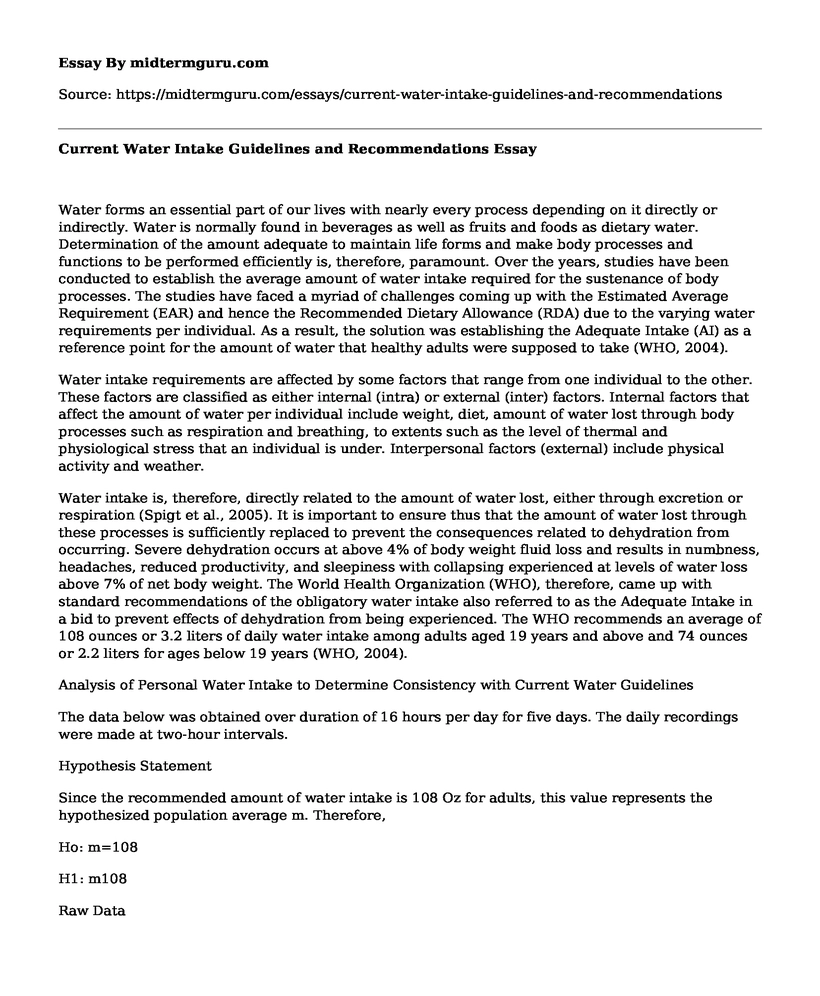Water forms an essential part of our lives with nearly every process depending on it directly or indirectly. Water is normally found in beverages as well as fruits and foods as dietary water. Determination of the amount adequate to maintain life forms and make body processes and functions to be performed efficiently is, therefore, paramount. Over the years, studies have been conducted to establish the average amount of water intake required for the sustenance of body processes. The studies have faced a myriad of challenges coming up with the Estimated Average Requirement (EAR) and hence the Recommended Dietary Allowance (RDA) due to the varying water requirements per individual. As a result, the solution was establishing the Adequate Intake (AI) as a reference point for the amount of water that healthy adults were supposed to take (WHO, 2004).
Water intake requirements are affected by some factors that range from one individual to the other. These factors are classified as either internal (intra) or external (inter) factors. Internal factors that affect the amount of water per individual include weight, diet, amount of water lost through body processes such as respiration and breathing, to extents such as the level of thermal and physiological stress that an individual is under. Interpersonal factors (external) include physical activity and weather.
Water intake is, therefore, directly related to the amount of water lost, either through excretion or respiration (Spigt et al., 2005). It is important to ensure thus that the amount of water lost through these processes is sufficiently replaced to prevent the consequences related to dehydration from occurring. Severe dehydration occurs at above 4% of body weight fluid loss and results in numbness, headaches, reduced productivity, and sleepiness with collapsing experienced at levels of water loss above 7% of net body weight. The World Health Organization (WHO), therefore, came up with standard recommendations of the obligatory water intake also referred to as the Adequate Intake in a bid to prevent effects of dehydration from being experienced. The WHO recommends an average of 108 ounces or 3.2 liters of daily water intake among adults aged 19 years and above and 74 ounces or 2.2 liters for ages below 19 years (WHO, 2004).
Analysis of Personal Water Intake to Determine Consistency with Current Water Guidelines
The data below was obtained over duration of 16 hours per day for five days. The daily recordings were made at two-hour intervals.
Hypothesis Statement
Since the recommended amount of water intake is 108 Oz for adults, this value represents the hypothesized population average m. Therefore,
Ho: m=108
H1: m108
Raw Data
Days/Interval 6-8am (Oz) 8-10am (Oz) 10-12 (Oz) 12-2pm (Oz) 2-4pm (Oz) 4-6pm (Oz) 6-8pm (Oz) 8-10pm (Oz) Total (Oz)
1 4 0 8 10 12 8 4 6 52
2 0 3 9 10 10 6 5 5 48
3 2 4 6 9 14 4 6 0 45
4 4 1 7 8 6 4 0 6 36
5 6 6 4 16 14 2 4 8 60
Day Average Oz/ 2 hours Average Oz/ Hour
1 3.25 1.63
2 3.00 1.50
3 2.81 1.41
4 2.25 1.10
5 3.75 1.88
Data Analysis and Results
Average daily water intake= 1/5(52+48+45+36+60)= 48.2 ounces per day
Variance of daily water intake=1/4{(52-48.2)2+(48-48.2)2+(45-48.2)2+(36-48.2)2+(60-48.2)2}
Variance= 78.2
Standard deviation of daily water intake = 78.2 = 8.84 Oz
Standard error=8.84/ 5 =3.9534
Students T-test statistic= (48.2-108)/ 3.9534 = -15.12
|t|= 15.12
T critical= 2.7764
Therefore, |t statistic| > t critical. Reject Ho.
Alternative: Excel Output
t-Test: Two-Sample Assuming Unequal Variances
Water Intake Amount (Oz) Dummy
Mean 48.2 0
Variance 78.2 0
Observations 5 2
Hypothesized Mean Difference 108 df 4 t Stat -15.12107995 P(T<=t) one-tail 5.57484E-05 t Critical one-tail 2.131846782 P(T<=t) two-tail 0.000111497 t Critical two-tail 2.776445105
P-value (0.00011) is less than the 0.05 level of significance. The null hypothesis Ho is, therefore, rejected.
Conclusion
My average daily water intake is thus not consistent with the recommended water intake guidelines of taking an average of 108 ounces of water per day.
References
Spigt, M. G., Kuijper, E. C., Schayck, C. P., Troost, J., Knipschild, P. G., Linssen, V. M., & Knottnerus, J. A. (2005). Increasing the daily water intake for the prophylactic treatment of headache: a pilot trial. European journal of neurology, 12(9), 715-718.
World Health Organization. (2004). Guidelines for drinking-water: recommendations (Vol. 1). World Health Organization.
Cite this page
Current Water Intake Guidelines and Recommendations. (2021, May 27). Retrieved from https://midtermguru.com/essays/current-water-intake-guidelines-and-recommendations
If you are the original author of this essay and no longer wish to have it published on the midtermguru.com website, please click below to request its removal:
- Climate Change Due to Human Activity - Essay Sample
- Essay Sample on Environmental Issue With Our Oceans
- How Scientist Learns About Past Global Temperature and Climate - Essay Sample
- Hurricane Scenario - Essay Sample
- Recovery After Attack: Short-Term vs Long-Term Process - Essay Sample
- Global Warming: Becoming Mindful of Environmental Issues & Solutions - Essay Sample
- Effects of Global Climate Change on the Acidification of the Ocean and Coastal Upwelling







